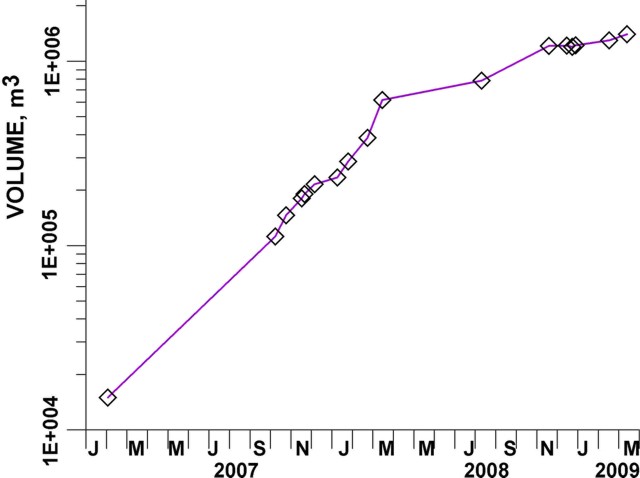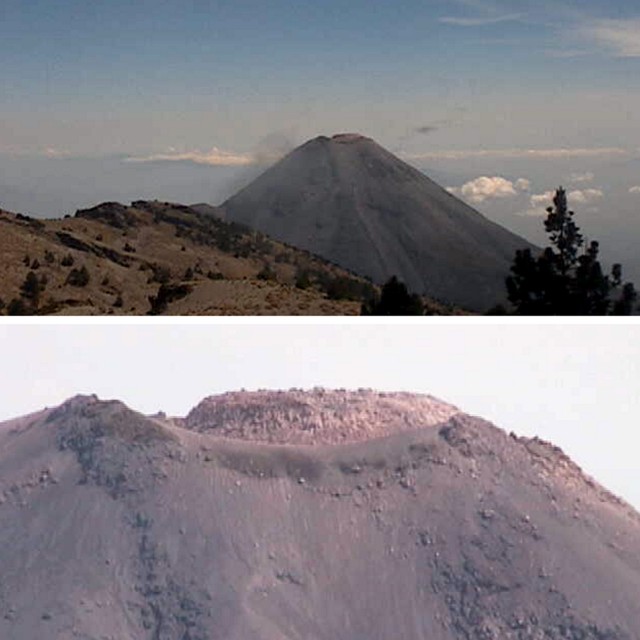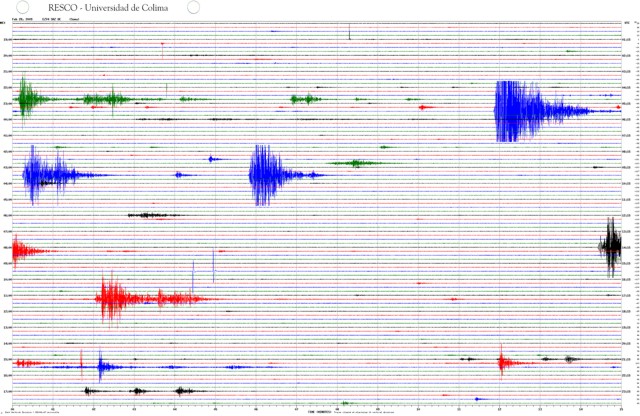Report on Colima (Mexico) — April 2009
Bulletin of the Global Volcanism Network, vol. 34, no. 4 (April 2009)
Managing Editor: Richard Wunderman.
Colima (Mexico) Persisting lava dome growth into at least mid-2009
Please cite this report as:
Global Volcanism Program, 2009. Report on Colima (Mexico) (Wunderman, R., ed.). Bulletin of the Global Volcanism Network, 34:4. Smithsonian Institution. https://doi.org/10.5479/si.GVP.BGVN200904-341040
Colima
Mexico
19.514°N, 103.62°W; summit elev. 3850 m
All times are local (unless otherwise noted)
Our most recent reports on Colima (BGVN 33:04 and 33:10) discussed new dome growth between February 2007 and November 2008. This report provides an update on the dome growth through May 2009.
According to a report from the Colima Observatory, the slow growth of Colima's new lava dome continued (figure 90). By March 2009, the volume was about 1,400,000 m3, roughly 80% of the total crater volume. Since the beginning of October 2007 the mean effusion rate has been ~ 0.03 m3/s. During the last two years, dome growth has been accompanied by 5-10 small explosions daily without significant variations (figure 91).
 |
Figure 90. Dome volume versus time at Colima during January 2007 to March 2009. Courtesy of Colima Volcano Observatory. |
To improve monitoring of the dome growth and any lava flows, pyroclastic flows, and explosive columns, the video station Nevado has been upgraded with two additional video cameras. These cameras allow digital images of the crater and the whole volcanic edifice of Colima to be taken every 4 seconds (figure 92). The station is situated at ~ 4,000 m elevation, below the summit of Nevado de Colima and 5.8 km N of the Volcán de Colima crater.
 |
Figure 92. Photos of Colima showing the edifice (top) and close-up of the crater (bottom). View is from the Nevado video station on 25 March 2009. Courtesy of Colima Volcano Observatory. |
Table 18 contains a condensation of reports on Colima ash plumes and selected eruptions during 4 January 2006 though 25 May 2009.
Table 18. Ash plumes from Colima seen between 4 January 2006 and May 2009. The plume altitudes (height above mean sea level) are approximate and indicate the highest plume during the specified period. Incandescent ejections are meters above the summit. Data from the Washington Volcanic Ash Advisory Center, Universidad de Colima, Gobierno del Estado de Colima, and news articles.
| Date | Max plume altitude (km) | Plume drift direction | Remarks |
| 04 Jan-09 Jan 2006 | 6.7 | NE, SW | -- |
| 11 Jan-15 Jan 2006 | 9.1 | ENE | -- |
| 04 Feb-07 Feb 2006 | 8.5 | -- | -- |
| 22 Feb-26 Feb 2006 | 9.1 | NE | -- |
| 26 Mar-27 Mar 2006 | 6.1 | -- | -- |
| 01 Apr-03 Apr 2006 | 7.9 | -- | -- |
| 08 Jul 2006 | -- | -- | Ash emission to unknown height. |
| 29 Oct 2006 | 6.1 | S | -- |
| 06 Nov 2006 | 6.1 | NE | -- |
| 19 Nov 2006 | 5.5 | W, SW | -- |
| 30 Nov 2006 | 6.7 | SE, NE | -- |
| 15 Dec 2006 | -- | SE, W | Continuous ash-and-steam emissions. |
| 21 Mar-27 Mar 2007 | 5.2 | NE | Incandescent material to 50-150 m. |
| 11 Apr-16 Apr 2007 | 6.1 | W | Multiple, sometimes continuous ash-and-steam emissions. |
| 26 Apr 2007 | -- | NW | -- |
| 28 and 30 Apr 2007 | -- | -- | Incandescent material to 100 m. |
| 31 May 2007 | -- | S, SW | -- |
| 19 Sep-23 Sep 2007 | 4-4.9 | Various | -- |
| 31 Oct-01 Nov 2007 | 4.5 | N | -- |
| 26 Nov-29 Nov 2007 | 7.3 | W, NNE | Multiple steam and steam-and-ash plumes to 3.9-4.6 km. |
| 03 Dec-04 Dec 2007 | -- | -- | Multiple steam and steam-and-ash plumes to 3.9-4.6 km. |
| 12 Dec-18 Dec 2007 | 4-4.4 | Various | Multiple plumes. |
| 20 Dec-25 Dec 2007 | 4.3-4.7 | -- | -- |
| 29 Dec-30 Dec 2007 | 4-4.3 | Various | Incandescent material ejected. |
| 14 Feb-19 Feb 2008 | 4.4 | Various | -- |
| 12 Mar-18 Mar 2008 | 3.9-4.8 | Various | -- |
| 01 Apr-07 Apr 2008 | 4.2-6.4 | Various | Multiple plumes; incandescent material ejected 150 m; incandescent avalanches. |
| 08 Apr-15 Apr 2008 | 4.5-4.9 | Various | Multiple plumes; incandescent material ejected 50 m. |
| 13 May 2008 | -- | NW | -- |
| 03 Jun-09 Jun 2008 | 4-4.8 | Various | -- |
| 13 Aug-18 Aug 2008 | 4-4.7 | Various | Multiple plumes. |
| 22 Oct-28 Oct 2008 | 3.9-4.5 | Various | Multiple plumes. |
| 30 Oct-31 Oct 2008 | 4.1-4.3 | -- | White plumes. |
| 02 Nov 2008 | 4.6 | SW, E | Gray plumes. |
| 03 Dec-08 Dec 2008 | 6.4 | -- | Gray plumes and white plumes. |
| 09 Dec-16 Dec 2008 | 3.9-5.8 | SE, N | -- |
| 02 Jan 2009 | 4.1 | -- | Incandescent material ejected 100 m. |
| 03 Jan-05 Jan 2009 | 4-4.2 | Various | Multiple gray and white plumes. |
| 03 Feb-10 Feb 2009 | 3.9-4.9 | -- | Multiple gray and white plumes; incandescent material ejected 50 m. |
| 25 Feb-03 Mar 2009 | 3.9-4.5 | -- | Multiple gray and white plumes. |
| 25 Mar-31 Mar 2009 | 3.9-4.6 | Various | Multiple gray and white plumes. |
| 08 Apr-13 Apr 2009 | 3.9-5.2 | Various | Multiple gray and white plumes. |
| 21 May-25 May 2009 | 3.9-4.2 | E, SE, S | Multiple gray and white plumes. |
Geological Summary. The Colima complex is the most prominent volcanic center of the western Mexican Volcanic Belt. It consists of two southward-younging volcanoes, Nevado de Colima (the high point of the complex) on the north and the historically active Volcán de Colima at the south. A group of late-Pleistocene cinder cones is located on the floor of the Colima graben west and east of the complex. Volcán de Colima (also known as Volcán Fuego) is a youthful stratovolcano constructed within a 5-km-wide scarp, breached to the south, that has been the source of large debris avalanches. Major slope failures have occurred repeatedly from both the Nevado and Colima cones, producing thick debris-avalanche deposits on three sides of the complex. Frequent recorded eruptions date back to the 16th century. Occasional major explosive eruptions have destroyed the summit (most recently in 1913) and left a deep, steep-sided crater that was slowly refilled and then overtopped by lava dome growth.
Information Contacts: Observatorio Vulcanológico de la Universidad de Colima, Colima, Col., 28045, México (URL: https://portal.ucol.mx/cueiv/); Washington Volcanic Ash Advisory Center (VAAC), Satellite Analysis Branch (SAB), NOAA/NESDIS E/SP23, NOAA Science Center Room 401, 5200 Auth Rd, Camp Springs, MD 20746, USA (URL: http://www.ospo.noaa.gov/Products/atmosphere/vaac/); Gobierno del Estado de Colima (URL: http://www.colima-estado.gob.mx/2006/index.php).


